1st Air Fleet (Imperial Japanese Navy)
| 1st Air Fleet (IJNAS) 第一航空艦隊 (Dai-ichi Kōkū Kantai) | |
|---|---|
|
| |
| Active |
10 April 1941 – 14 July 1942 1 June 1943 – 15 June 1945 |
| Country |
|
| Allegiance |
|
| Type | Naval Air Fleet ('Kantai') |
| Engagements |
Pearl Harbor Indian Ocean Coral Sea Midway Santa Cruz Philippine Sea Leyte Gulf |
| Insignia | |
| Roundel |
 |
The 1st Air Fleet (第一航空艦隊 Daiichi Kōkū Kantai) formed the primary carrier fleet of the Imperial Japanese Navy (IJN), a group of naval aircraft and aircraft carriers that at the time of the attack on Pearl Harbor, was the world's largest aircraft carrier fleet. With the Kidō Butai as its primary carrier battle group, the IJN would reign supreme for the first six months of America's entry to World War II.
Origins

In 1912, the British Royal Navy had established its own flying branch, the Royal Naval Air Service (RNAS). The IJN was modeled on the Royal Navy and the IJN Admiralty sought establishment of their own Naval Air Service. The IJN had also observed technical developments in other countries and saw military potential of the airplane. In 1913, the IJN seaplane carrier Wakamiya was converted into a seaplane tender and aircraft were purchased. The 1st and 2nd Air Fleet were to be the primary attack force of the IJNAS.
Organization
The Imperial Japanese Navy Air Service's carrier-based Air Corps or Naval Air Group (Kōkūtai) was a major component of the Combined Fleet (Rengō Kantai), and whose size (from a handful to 80 or 90 aircraft) was dependent on the mission and type of aircraft carrier used.[1] Several Kōkūtai formed a Koku Sentai (Naval Air Flotilla or Carrier Division), while a Naval Air Fleet (Kantai) was made up of several Koku Sentai.[2]
As Carrier Task Force
On 10 April 1941 the Imperial Japanese Navy formed the First Air Fleet (Dai-ichi KōKū Kantai) consisting of all seven of Japan's aircraft fleet carriers and light carriers with a total of 474 aircraft. This was a naval battlegroup at the time with the single most powerful concentration of naval aviation in the world.[3]
The large fleet carriers had three types of aircraft; fighters, level/torpedo bombers, and dive bombers. The smaller carriers tended to have only two types of aircraft, fighters and torpedo bombers. The carrier-based Kōkūtai numbered over 1500 pilots with over 1500 aircraft. At the beginning of the Pacific War, there would be 6 fleet carriers—Akagi, Kaga, Soryu, Hiryu, Shokaku, and Zuikaku—and two light carriers, Ryujo and Zuiho.
Kidō Butai
The Kidō Butai (機動部隊, "Mobile Unit/Force") was the Combined Fleet's tactical designation for its carrier battle group.[4] The title was used as a term of convenience; it was not a formal name for the organization. It consisted of Japan's six largest carriers, carrying the 1st Air Fleet. This mobile task force was created for executing the attack on Pearl Harbor under Admiral Chūichi Nagumo in 1941.[5] For the attack on Pearl Harbor, the Kidō Butai consisted of six aircraft carriers (commanded by Chuichi Nagumo, Tamon Yamaguchi and Chūichi Hara) with 414 airplanes, two battleships, three cruisers, nine destroyers, eight tankers, 23 submarines, and four midget submarines. However, these escort ships were borrowed from other fleet and squadrons. It was considered the single most powerful naval fleet until four of the six aircraft carriers of the unit were destroyed in the disastrous Battle of Midway. On 14 July 1942, all carriers were moved to the 3rd Fleet.
| Carriers of the Kidō Butai, 1941 | |
|---|---|
| 1st Carrier Division | |
| Akagi | |
| Kaga | |
| 2nd Carrier Division | |
| Sōryū | |
| Hiryū | |
| 3rd Carrier Division | |
| Zuihō | |
| Hōshō | |
| 4th Carrier Division | |
| Ryūjō | |
| Taiyō | |
| 5th Carrier Division | |
| Shōkaku | |
| Zuikaku | |
Transition (extract)
| Date | Lower units | Lowest units and ships |
|---|---|---|
| 10 April 1941 (original) | 1st Carrier Division | Akagi, Kaga |
| Destroyer Division 7: Akebono, Ushio | ||
| 2nd Carrier Division | Sōryū, Hiryū | |
| Destroyer Division 23: Kikuzuki, Uzuki | ||
| 4th Carrier Division | Ryūjō | |
| 10 December 1941 | 1st Carrier Division | Akagi, Kaga |
| Destroyer Division 7: Akebono, Ushio | ||
| 2nd Carrier Division | Sōryū, Hiryū | |
| Destroyer Division 23: Kikuzuki, Uzuki | ||
| 4th Carrier Division | Ryūjō, Kasuga Maru | |
| Destroyer Division 3: Shiokaze, Hokaze | ||
| 5th Carrier Division | Shōkaku, Zuikaku, Oboro, Akigumo | |
| 10 April 1942 | 1st Carrier Division | Akagi, Kaga |
| 2nd Carrier Division | Hiryū, Sōryū | |
| 4th Carrier Division | Ryūjō, Shōhō | |
| 5th Carrier Division | Shōkaku, Zuikaku | |
| 10th Cruiser-Destroyer Squadron | Nagara | |
| Destroyer Division 4: Nowaki, Arashi, Hagikaze, Maikaze | ||
| Destroyer Division 10: Kazagumo, Makigumo, Yūgumo, Akigumo | ||
| Destroyer Division 17: Urakaze, Isokaze, Tanikaze, Hamakaze | ||
| 14 July 1942 | disbanded | |
Commanders
- Commander in Chief
| Rank | Name | From | To | |
|---|---|---|---|---|
| 1 | Vice-Admiral | Chūichi Nagumo | 10 April 1941 | 14 July 1942 |
- Chief of Staff
| Rank | Name | From | To | |
|---|---|---|---|---|
| 1 | Rear-Admiral | Ryūnosuke Kusaka | 10 April 1941 | 14 July 1942 |
As land-based Air Fleet
On 1 June 1943, the 1st Air Fleet was reborn as the land-based Air Fleet. On 30 September 1943, a cabinet meeting planned the Absolute National Defence Zone (絶対国防圏 Zettai Kokubōken) strategy.[6] The plan intended the Kuril Islands, Bonin Islands, Mariana Islands, Caroline Islands, Geelvink Bay (Biak), Sunda Islands and Burma to be unsinkable aircraft carriers. The 1st Air Fleet became the main force of this plan. However, it was soundly beaten in the Battle of Philippine Sea. The IJN then moved the air fleet to the Philippines to regroup. However, the IJN lost the air fleet, as it was not combat ready in the Aerial Battle of Taiwan–Okinawa. After the battle it had only 30 aircraft. The only tactic left for them was the kamikaze attack.
Transition (extract)
| Date | Higher unit | Lower units | Lowest units |
|---|---|---|---|
| 1 June 1943 (original) | Imperial General Headquarters | 261st NAG (Naval Air Group or Naval Aviation Group)., 521st NAG, 761st NAG | |
| 1 January 1944 | Imperial General Headquarters | 121st NAG, 261st NAG, 263rd NAG, 265th NAG, 321st NAG, 341st NAG, 344th NAG, 521st NAG, 523rd NAG, 1021st NAG | |
| 15 February 1944 | Combined Fleet | 61st Air Flotilla | 121st NAG, 261st NAG, 263rd NAG, 321st NAG, 341st NAG, 343rd NAG, 521st NAG, 523rd NAG, 763rd NAG, 1021st NAG |
| 62nd Air Flotilla | 141st NAG, 262nd NAG, 265th NAG, 322st NAG, 345th NAG, 361st NAG, 522nd NAG, 524th NAG, 541st NAG, 762nd NAG | ||
| 5 May 1944 | Combined Fleet | 22nd Air Flotilla | 151st NAG, 202nd NAG, 251st NAG, 253rd NAG, 301st NAG, 503rd NAG, 551st NAG, 755th NAG |
| 26th Air Flotilla | 201st NAG, 501st NAG, 751st NAG | ||
| 61st Air Flotilla | 121st NAG, 261st NAG, 263rd NAG, 321st NAG, 341st NAG, 343rd NAG, 521st NAG, 523rd NAG, 763rd NAG, 1021st NAG | ||
| 7 August 1944 | Southwest Area Fleet | 22nd Air Flotilla | Higashi-Caroline NAG |
| 23rd Air Flotilla | Gōhoku NAG | ||
| 26th Air Flotilla | Hitō NAG | ||
| 61st Air Flotilla | Mariana NAG, Nishi-Caroline NAG | ||
| 153rd NAG, 201st NAG, 221st NAG, 761st NAG, 1021st NAG | |||
| 15 December 1944 | Southwest Area Fleet | 23rd Air Flotilla | Gōhoku NAG |
| 26th Air Flotilla | Hokuhi NAG, Chūhi NAG, Nanpi NAG | ||
| 153rd NAG, 201st NAG, 761st NAG, 1021st NAG | |||
| 1 March 1945 | Southwest Area Fleet | 26th Air Flotilla | Hokuhi NAG, Chūhi NAG, Nanpi NAG, 141st NAG, 153rd NAG, 201st NAG, 221st NAG, 341st NAG, 761st NAG, 763rd NAG |
| Taiwan NAG, 132nd NAG, 133rd NAG, 165th NAG, 634th NAG, 765th NAG, 1021st NAG | |||
| 8 May 1945 | Combined Fleet | 132nd NAG, 133rd NAG, 205th NAG, 765th NAG | |
| 15 June 1945 | disbanded | ||
Commanders
- Commander in chief
| Rank | Name | Date | Note | |
|---|---|---|---|---|
| 1 | Vice-Admiral | Kakuji Kakuta | 1 June 1943 | KIA on 2 August 1944. |
| x | vacant post | 3 August 1944 | (after unnoticed death of Vice-Admiral Kakuta) | |
| 2 | Vice-Admiral | Kinpei Teraoka | 7 August 1944 | |
| 3 | Vice-Admiral | Takijirō Ōnishi | 20 October 1944 | |
| 4 | Vice-Admiral | Kiyohide Shima | 10 May 1945 | |
| x | disbanded | 15 June 1945 |
- Chief of Staff
| Rank | Name | Date | Note | |
|---|---|---|---|---|
| 1 | Captain / Rear-Admiral | Yoshitake Miwa | 1 June 1943 | KIA on 2 August 1944. Posthumly promoted to Rear-Admiral on same day. |
| x | vacant post | 3 August 1944 | (After unnoticed death of Captain Miwa) | |
| 2 | Captain | Toshihiko Odawara | 7 August 1944 | |
| 3 | Rear-Admiral | Tomozō Kikuchi | 1 January 1945 | |
| 4 | Rear-Admiral | Tasuku Nakazawa | 10 May 1945 | |
| x | disbanded | 15 June 1945 |
-
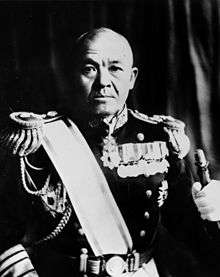
Admiral Chūichi Nagumo (Commander-in-Chief, 1st Carrier Division)
-

Vice Admiral Tamon Yamaguchi (2nd Carrier Division)
-
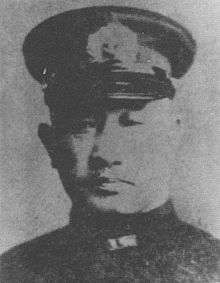
Vice Admiral Kakuji Kakuta (4th Carrier Division - from 1941)
-

Vice Admiral Chūichi Hara (5th Carrier Division)
-

Vice Admiral Gunichi Mikawa (3rd Battleship Division)
-

Vice Admiral Sentarō Ōmori (1st Destroyer Squadron)
-

Vice Admiral Shigeyoshi Miwa (3rd Submarine Squadron)
-
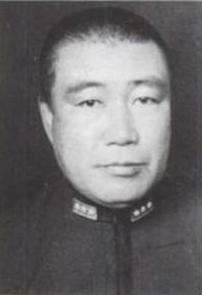
Vice Admiral Ryūnosuke Kusaka (Chief of staff, 1st Air Fleet)
-

Rear Admiral Tomeo Kaku (2nd Carrier Division: Hiryu)
-
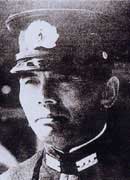
Rear Admiral Ryusaku Yanagimoto (2nd Carrier Division: Soryu)
Operations

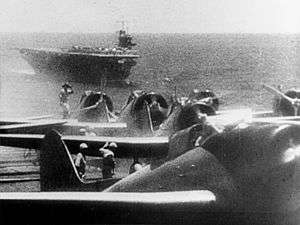
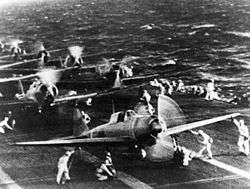

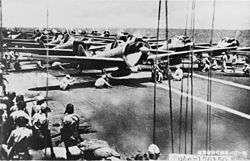
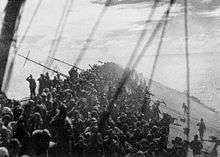
Pearl Harbor
The Kidō Butai (also known as the Carrier Striking Task Force) set sail from Hittokapu Bay, Japan under Vice Admiral Chūichi Nagumo on 26 November 1941, arriving in Hawaiian waters on Sunday December 7, 1941 Hawaiian time. At around 8am, the first wave began its attack on the US Pacific Fleet based at Pearl Harbor and on outlying airfields. By the end of the day 21 American ships were either sunk or crippled, 188 aircraft were destroyed, and over 3,500 American personnel were casualties of war. Japan was now formally at war with the United States.
For the attack on Pearl Harbor, this fleet had a strength of 103 level bombers, 128 dive bombers, 40 torpedo bombers, 88 fighter planes, and plus 91 planes with a total of 441 planes.
Indian Ocean Raid
Between 31 March and 10 April 1942 the Japanese conducted a naval sortie against Allied naval forces in the Indian Ocean. The Fast Carrier Task Force (Kidō Butai), consisting of six carriers commanded by Admiral Chūichi Nagumo, inflicted heavy losses on the British fleet, with the sinking of 1 carrier, 2 cruisers, 2 destroyers, and 23 merchant ships for the loss of 20 aircraft. Attacks on the island of Ceylon were also carried out.
Battle of the Coral Sea
The 1st Air Fleet dispatched the Fifth Carrier Division in the Coral Sea during the return from the Indian Ocean. On May 7 the USN sighted the Port Moresby invasion force and mistook it for the main carrier force. Admiral Fletcher sent an aircraft strike which sank the IJN light carrier Shōhō. After this loss of air cover, the Port Moresby invasion force abandoned its mission and retreated north. On the same day the IJN sighted and sank USN destroyer Sims and oiler Neosho. The primary action took place on 8 May. Both carrier forces sighted and attacked each other. As a result, Lexington was sunk and Yorktown was damaged by a Japanese air strike. USN aircraft managed to damage Shōkaku, meaning that she and her sister ship were unable to participate in the following operation. The remaining fleet returned to Japan to prepare for the Midway invasion (Operation MI).
Battle of Midway
Admiral Isoroku Yamamoto planned to lure and destroy USN carriers by attacking the Midway Islands in June 1942. The Japanese were unaware that the United States had broken their naval code. As a result of this, USN carriers were already in the area when the Japanese attacked Midway. On 3 June US land-based bombers from Midway attacked the Japanese fleet but scored no hits. On 4 June, due to the poor reconnaissance efforts and tactical mistakes of Vice Admiral Chūichi Nagumo, USN dive bombers were able to surprise the Japanese carrier force and destroyed three carriers (Akagi, Kaga and Sōryū). At the time of the attack the Japanese carriers were in the process of preparing to launch an air strike against the US carriers and their hangars were full of loaded aircraft, bombs and aviation fuel which decisively contributed to their destruction. Carrier Hiryū managed to survive the attack and Rear Admiral Tamon Yamaguchi launched a strike against Yorktown. Aircraft from Hiryū managed to cripple Yorktown, which was later sunk by a Japanese submarine I-168. In response, US launched a strike against Hiryū and sunk her. That day the Japanese lost four aircraft carriers and much of their experienced aircrew.
Battle of the Eastern Solomons
The battle took place in August 1942. It was one of the two battles around the Solomon Islands where the IJN carrier force engaged USN carrier force. As a response to Allied landings on Guadalcanal in early August, the Japanese planned a counterattack for late August. On 24 August the IJN carrier force (Shōkaku, Zuikaku and Ryūjō) under the command of Vice Admiral Chūichi Nagumo arrived in the Solomons area. Ryūjō was then separated and sent to attack Henderson Field. She was spotted by US reconnaissance aircraft that morning. Admiral Fletcher sent a strike force in the afternoon which sunk her. About the same time the Japanese sighted the US carrier force (Enterprise and Saratoga) and launched an air strike which badly damaged Enterprise.
Battle of Santa Cruz Islands
This was the second carrier battle of the Guadalcanal Campaign. The Japanese Army planned a major ground offensive on Guadalcanal for the end of October 1942. The Japanese Navy was to support this offensive. The IJN force consisted of four carriers (Shōkaku, Zuikaku, Jun'yō and light carrier Zuihō). The USN had two carriers available at the time (Enterprise and Hornet). The two forces first sighted each other in the morning of 26 October. In the following air strikes, the USN managed to heavily damage Shōkaku and Zuihō. In exchange, the IJN sank carrier Hornet and badly damaged Enterprise. Despite the tactical victory of the Japanese at the Battle of Santa Cruz Islands, their experienced aircrew was almost entirely wiped out in the two carrier battles around the Solomon Islands and they were no longer able to conduct carrier operations for some time.
Battle of the Philippine Sea
The Invasion of Mariana Islands in June 1944 came as a surprise to the Japanese who had expected the next US target to be either the Palau Islands or the Caroline Islands. In response, the IJN moved to counterattack the US forces. Vice Admiral Jisaburō Ozawa had five large carriers (Taihō, Shōkaku, Zuikaku, Jun'yō and Hiyō) and an additional four light carriers under his command. By this time, the IJN was able to train new aircrew for their carriers to replace those lost during the battles in 1942, but their training was superficial and they had no combat experience. The US 5th Fleet, under the command of Raymond A. Spruance, had seven fleet carrier and eight light carriers. On 19 June Ozawa launched four successive air strikes against the USN ships but they were all destroyed by the combination of radar, new carrier-borne fighters (F6F Hellcat), and pilots that were better-trained and had much combat experience. That same day USN submarines managed to sink the new Japanese aircraft carrier Taihō as well as Shōkaku. The next day, a USN counter-attack sank carrier Hiyō and damaged three more carriers. Overall the Japanese lost more than four hundred aircraft with their newly trained aircrew.
Battle of Leyte Gulf
After disastrous losses at the Battle of the Philippine Sea, the Japanese carrier force was again practically without aircrew and aircraft. This meant that at the Battle of Leyte Gulf the IJN carrier force was only used as a decoy force where it was ultimately destroyed, the battle that saw the last Kidō Butai survivor, Zuikaku, along with Zuiho, Chiyoda and Chitose succumbing to US air attacks of Admiral William F. Halsey's Task Force 38.
References
- Citations
- ↑ IJN 1st Air Fleet Retrieved 8 September 2010.
- ↑ Thorpe 1977, p. 12.
- ↑ Stories and Battle Histories of the IJN's Carrier Fleet Retrieved 8 September 2010.
- ↑ Klemen, L. "Vice-Admiral Chuichi Nagumo". Forgotten Campaign: The Dutch East Indies Campaign 1941–1942.
- ↑ Parshall and Tully, pp. 6 & 535.
- ↑ http://www.ndl.go.jp/horei_jp/kakugi/txt/txt00504.htm (今後採ルヘキ戦争指導ノ大綱) by National Diet Library. Accessed 2009-05-28. Archived 2009-05-30.
- Bibliography
- Parshall, Jonathan; Tully, Anthony (2005). Shattered Sword: The Untold Story of the Battle of Midway. Dulles, Virginia: Potomac Books. ISBN 1-57488-923-0.
- Thorpe, Donald W. Japanese Naval Air Force Camouflage and Markings World War II. Fallbrook, CA: Aero Publishers, Inc., 1977. ISBN 0-8168-6583-3 (hardcover; paperback ISBN 0-8168-6587-6).
- "Monthly the Maru" series, and "The Maru Special" series, "Ushio Shobō". Archived from the original on 2009-05-30. (Japan)
- "Monthly Ships of the World" series, "Kaijinsha". Archived from the original on 2009-05-30. (Japan)
- "Famous Airplanes of the World" series and "Monthly Kōku Fan" series, Bunrindō (Japan)
